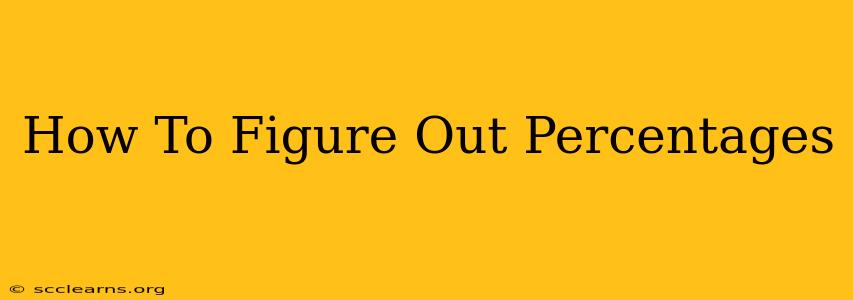Percentages are a fundamental part of everyday life, from calculating sales tax and discounts to understanding statistics and financial reports. Understanding how to figure out percentages is a valuable skill that can greatly simplify many tasks. This guide breaks down the process into easy-to-follow steps, covering various scenarios and providing practical examples.
Understanding the Basics
A percentage is a fraction or ratio expressed as a number out of 100. The symbol "%" represents "percent," meaning "out of 100" or "per hundred." For example, 50% means 50 out of 100, which is equivalent to 50/100 or 1/2 (one-half).
Key Concepts:
- Percentage: The portion of a whole expressed as a number out of 100.
- Whole (or Base): The total amount you're working with.
- Part: The portion of the whole that represents the percentage.
Calculating Percentages: Methods and Examples
There are several ways to calculate percentages, depending on the information you have. Here are some common methods:
Method 1: Using the Formula
The most fundamental formula for calculating percentages is:
(Part / Whole) * 100 = Percentage
Example: What percentage of 20 is 5?
- Identify the parts: Part = 5, Whole = 20
- Apply the formula: (5 / 20) * 100 = 25%
Therefore, 5 is 25% of 20.
Method 2: Finding the Percentage of a Number
To find a percentage of a number, convert the percentage to a decimal and multiply it by the number.
Example: Find 30% of 150.
- Convert the percentage to a decimal: 30% = 30/100 = 0.30
- Multiply the decimal by the number: 0.30 * 150 = 45
Therefore, 30% of 150 is 45.
Method 3: Calculating Percentage Increase or Decrease
Percentage change is calculated by finding the difference between the two numbers, dividing by the original number, and multiplying by 100.
Formula: [(New Value - Old Value) / Old Value] * 100 = Percentage Change
Example: A product's price increased from $50 to $60. What is the percentage increase?
- Find the difference: $60 - $50 = $10
- Divide by the original value: $10 / $50 = 0.2
- Multiply by 100: 0.2 * 100 = 20%
Therefore, the price increased by 20%.
Practical Applications of Percentages
Percentages are used extensively in various real-world situations:
- Sales and Discounts: Calculating discounts in stores.
- Finance: Understanding interest rates, returns on investments, and tax calculations.
- Statistics: Analyzing data and interpreting results.
- Science: Representing proportions and ratios in experiments.
Tips for Mastering Percentages
- Practice regularly: The more you practice, the more comfortable you'll become with calculating percentages.
- Use a calculator: Calculators can be incredibly helpful, especially for complex calculations.
- Break down complex problems: If you encounter a challenging problem, break it down into smaller, manageable steps.
- Check your work: Always double-check your calculations to ensure accuracy.
By understanding the basic methods and practicing regularly, you can easily master the skill of calculating percentages and apply it to various aspects of your life. Remember, consistent practice is key to building confidence and fluency with this essential mathematical concept.

